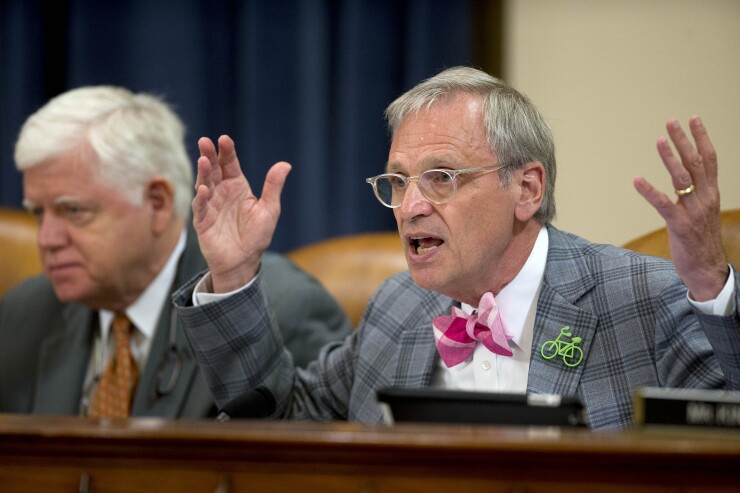WASHINGTON — Congressional proposals to expand the use of private activity bonds keep growing, with the latest coming from a bipartisan group of House lawmakers who want to raise the federal cap on private activity bonds for surface transportation and freight improvement projects by $5.8 billion.
The current volume cap on PABs issued for highways and freight improvement has just over $2.5 billion remaining that can be authorized by the U.S. Department of Transportation.
A total of $12.45 billion
The proposed Building United States Infrastructure and Leveraging Development (BUILD) Act introduced in the House this week is identical to a bipartisan Senate bill introduced in February by Sens. John Cornyn, R-Texas, and Mark Warner, D-Va.
Two House Democrats — Reps. Earl Blumenauer of Oregon and Terri Sewell of Alabama — have teamed up with Republican Reps. Mike Kelly of Pennsylvania and Rodney Davis of Illinois as lead cosponsors.
“Public-Private partnerships are one of a myriad of tools the nation needs to bridge the $2 trillion infrastructure investment gap,” Blumenauer said in a press statement announcing the introduction of the bill.

“I am hopeful that this bipartisan legislation will be part of any upcoming effort to rebuild and renew America,” he said.
The current $15 billion cap was established in 2005 under the Safe, Accountable, Flexible, Efficient Transportation Equity Act: A Legacy for Users (SAFETEA-LU), which authorized a new type of tax-exempt private activity bonds that could be issued by state or local governments to finance qualified highway or surface freight transfer facilities.
The 2005 legislation designated DOT as the key agency for allocating these transportation PABs.
The transportation and freight PABs are among 22 eligible PABs that are subject to varying federal rules, according to the nonpartisan Congressional Research Service.
Thirteen of the 22 activities are subject to annual state volume caps. Among them are multifamily housing bonds, single-family mortgage revenue bonds and qualified student loan bonds. Others include small issue bonds, redevelopment bonds, exempt facility bonds such as water and sewage facilities, hazardous waste facilities and other utility facilities.
Among the PABs not subject to volume caps are those financing airports, docks, wharves and projects for 501(c)(3) organizations.
The transportation and freight PABs have been used for 35 projects in a wide range of states from Colorado to Illinois, Indiana and Ohio with another five allocated and not yet issued.
The projects include $460.9 million in PABs used for construction of a new Goethels Bridge between Staten Island in New York City and northern New Jersey, $737 million used for the so-called "Transform 66 Project" to widen Interstate 66 in the Virginia suburbs of Washington and two projects of $400 million and $274 million involving the North Tarrant Expressway in Tarrant County, Texas. Another $750 million for the North Tarrant Expressway has been allocated but not yet issued.
Another notable example of how these PABs have been used is through the Florida Development Finance Corp. to help private investors finance a high speed rail project between Miami and Orlando formerly known as Brightline and recently renamed Virgin Trains USA.
Other bills to expand the use of PABs include the Move America Bonds Act, which would leverage $8 billion in federal investment into $226 billion worth of bond authority over the next 10 years or up to $56 billion over 10 years in tax credits, according to an estimate by the nonpartisan congressional Joint Committee on Taxation.
Move America Bonds could be used for a wide variety of projects, including airports, ports, transit, freight and passenger rail, roads, bridges, flood projects, inland and coastal waterway improvements, wastewater and sewage facilities, and broadband infrastructure.
Another PABs bill is the bipartisan Public Buildings Renewal Act that would authorize $5 billion in private activity bonds for the construction or rehabilitation government-owned buildings.
That bill, which had the support of leading state and local elected officials in the last Congress, would provide an economic boost of more than $8 billion in the first year, according to a 2017 study by the Beacon Hill Institute.
Shelly Sigo contributed to this report.





